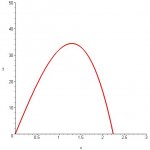SeekerOfDragons
New member
- Joined
- Oct 8, 2009
- Messages
- 46
I'm trying to verify my answer to the following:
Find the area of the largest rectangle with lower base on the x-axis and upper vertices on the parabola y = 20 - 4X^2
Area of Rectangle = Length * Width
Set Length = X
Set Width = Y
A(X) = X * Y
A(X) = X(20 - 4X^2)
A(X) = 20X - 4X^3
A'(X) = 20 - 12X^2
20 = 12X^2
X^2 = 20/12 = 5/3
X = -Sqrt (5/3), Sqrt (5/3)
Using First Derivative Test, determined Sqrt(5/3) is a max.
A(X) = X(20 - 4X^2)
A(Sqrt(5/3)) = Sqrt(5/3)(20 - 4(Sqrt(5/3)^2)
A(Sqrt(5/3)) = Sqrt(5/3)(20 - 4 (5/3))
A(Sqrt(5/3)) = Sqrt(5/3)(20 - 20/3)
A(Sqrt(5/3)) = Sqrt(5/3)(40/3)
Area of Rectangle = 40 Sqrt(15) / 3 units^2 OR Approx 51.64 units^2
Find the area of the largest rectangle with lower base on the x-axis and upper vertices on the parabola y = 20 - 4X^2
Area of Rectangle = Length * Width
Set Length = X
Set Width = Y
A(X) = X * Y
A(X) = X(20 - 4X^2)
A(X) = 20X - 4X^3
A'(X) = 20 - 12X^2
20 = 12X^2
X^2 = 20/12 = 5/3
X = -Sqrt (5/3), Sqrt (5/3)
Using First Derivative Test, determined Sqrt(5/3) is a max.
A(X) = X(20 - 4X^2)
A(Sqrt(5/3)) = Sqrt(5/3)(20 - 4(Sqrt(5/3)^2)
A(Sqrt(5/3)) = Sqrt(5/3)(20 - 4 (5/3))
A(Sqrt(5/3)) = Sqrt(5/3)(20 - 20/3)
A(Sqrt(5/3)) = Sqrt(5/3)(40/3)
Area of Rectangle = 40 Sqrt(15) / 3 units^2 OR Approx 51.64 units^2

